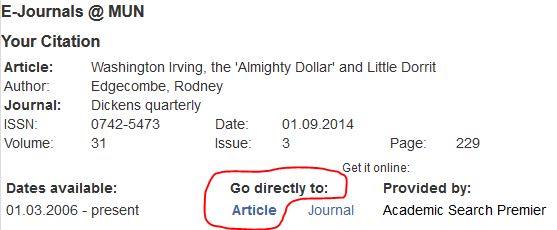How to find articles
Journal articles give an in-depth analysis of a focused topic. The library subscribes to thousands of journals, many of which are available online.
We also subscribe to hundreds of article indexes to help you find articles. The library does NOT have every book and journal listed in the article indexes -- the indexes help you discover what has been written on a topic.
If you already know the title of the journal you need, search for it as a periodical title in the Library catalogue.
Follow the 5 step below to find journal articles efficiently.
Step 1: Choose an index
An article index is a type of search engine that identifies articles on a topic. The library subscribes to more than 200 article indexes on subjects from Anthropology to Zoology and everything in between.
To find article indexes, use Article Search. Under "Indexes by Subject", choose a subject.
On each subject page, indexes listed under "Try these first" are the largest or best for the subject. Indexes under "More specifically" focus on particular aspects of a subject. Browse the list in case your subject has its own special index. For example, try World Shakespeare Bibliography in addition to the more general Literature Online for a Shakespeare assignment.
Step 2: Search the index
Before you begin searching, think about your topic. Identify the concepts you want to search, and brainstorm keywords for each concept.
You must enter your search terms into the index so that the index correctly interprets what you want to find. There may be a different search format for each index you use. But there are some common elements among all indexes:
- Use truncation or wildcard (often it is an asterisk *) to retrieve all possible endings of a word.
e.g.: instruct* will find instruct, instructing, instructs, instructor, instruction, etc - Use AND to combine keywords for different concepts
- Use OR to combine synonyms for the same concept (and use brackets)
Example: For articles on methods for teaching children good hygiene, you might try:
(teach* or educat* or instruct*) and (child* or boy* or girl*) and hygiene
You may also be able to browse a list of subjects found in the index. Look for a list of subject headings, a magnifying glass icon, or a thesaurus list.
Step 3: Mark articles
In most indexes, you can create a list of relevant records to print, save to a file, or e-mail. Look for terms like "mark", "tag", or "add to folder" to create your shortlist of records to keep.
Step 4: Interpret citations
Article citations include a volume and issue, and may mention a day, month or season.

Book chapter citations include a place and publisher. Also look for the word IN, which tells you the citation is a chapter IN a book.

Step 5: Get the text
You need to find out whether MUN subscribes to the journal or owns the book. (Remember that the library does NOT own every book and journal listed in the article indexes.)
To get an article from an index:
- Look for links called Full Text or PDF. Click to open the full article. You're done!
- No full text links? Use the Get it at Memorial button for options
 .
. - No Get It button? Look up the journal title in the library catalogue (under "Search for", choose "periodical title").
The Get It at Memorial button will open a shortcut window to help you get the article. Example:
If the screen shows a message saying "there is no direct link to your resource," do not give up! Search the library catalogue for the resource using the "By Journal title" link (shown below).
If the resource is not in the library catalogue, you can order the item through Document Delivery.
For help, ask us.

